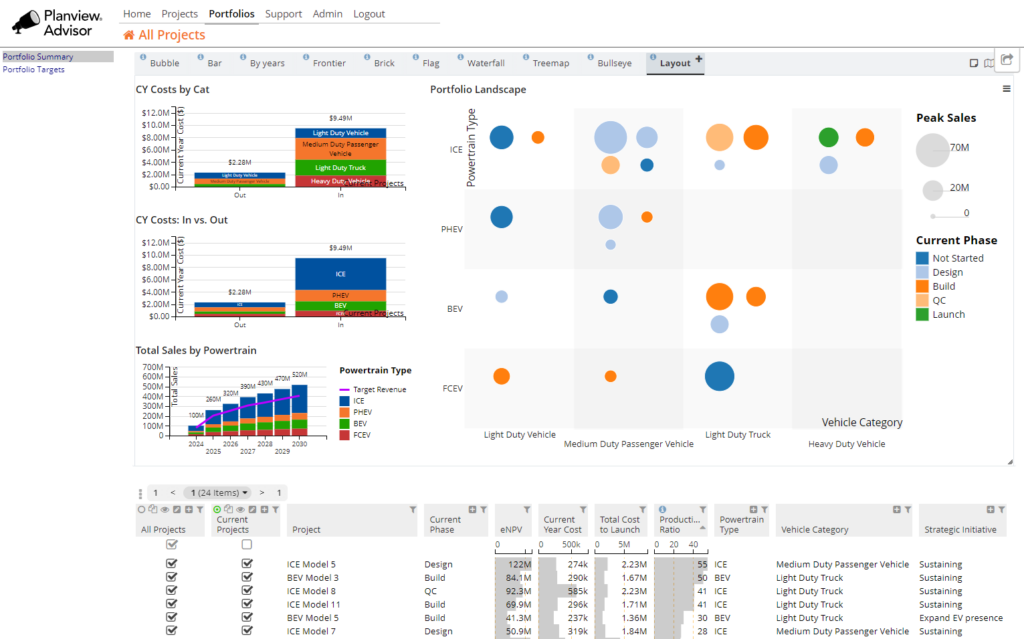
The automotive landscape is evolving, witnessing a subtle shift as the industry diversifies its focus to include a broader range of alternatives to both EVs and internal combustion engines (ICEs). This change, influenced by fluctuating demands and stricter regulations, underscores the need for agility and adaptability. Amidst this dynamic backdrop, automotive organizations find themselves at a crossroads, tasked with making strategic, future-proof investments that minimize risks.
In this complex environment, there’s an urgent call for sophisticated solutions that empower organizations to make well-informed business decisions. To illuminate these challenges and solutions, we’ll explore three key areas where automotive companies often place substantial bets, knowing that stakes are high and outcomes can have lasting implications. These key areas are:
- Product Development
- Capital Expenditures (CapEx)
- Marketing
Through this exploration, we will highlight the significance of balancing long-term vision and short-term objectives, considering various assumptions, scenarios, and interdependencies within the automotive landscape.
The Challenges and Solutions in Product Development
Navigating the landscape of product development (PD) in the automotive industry is akin to charting a course through shifting sands. With cars typically taking 7-10 years from conception to production, how can organizations ensure that today’s decisions remain relevant in a marketplace and regulatory environment that’s in constant flux? Consider the impact of evolving EPA regulations or new safety standards; these variables introduce uncertainties that can reshape development trajectories.
Financial complexities often challenge organizations, as traditional ERP (enterprise resource planning) systems struggle to manage the intricacies of PD business cases.
Moreover, the inherent riskiness of product investments can make aligning decisions with the decision-making process daunting. Strategic questions abound, such as determining the optimal powertrain mix across short- and long-term plans or deciding which models to fast-track or delay.
External factors like the global microchip shortage further complicate matters, prompting organizations to evaluate the viability of investing in autonomous vehicles and formulate contingency plans for global events using real-time data. Amidst these challenges, there’s a pressing need for a robust solution that offers several key benefits:
- Optimized PD Investments: A solution that maximizes returns across the PD portfolio.
- Advanced Analytics: Powerful capabilities, such as Monte Carlo simulations, that visualize technology risks, guiding decisions on new powertrains and technologies.
- Scenario Planning: What-if analyses that help organizations plan for evolving market conditions and regulatory shifts.
- Real-time Linkages: Seamless integration between product data and portfolio analysis, enabling agile responses to changing circumstances.
Automotive organizations need a solution that tackles PD complexities and enables informed decisions amid rapid industry changes.

Capitalizing on CapEx: The Automotive Investment Challenge
The automotive industry is one of the most capital-intensive sectors, yet many organizations still rely on static spreadsheets to manage these significant investments. This traditional approach poses the following challenges:
- Lack of a Single Source: Managing CapEx initiatives in spreadsheets leads to a fragmented view without a clear single source of truth.
- Inconsistent Evaluation: Varied methodologies across initiatives make it hard to see the bigger picture and ensure spending aligns with strategic goals.
- Flexibility Needs: To maximize decision-making flexibility, multiple investment scenarios are essential to invest appropriately in each initiative.
Decisions in CapEx range from basic choices about where to invest to scenario planning that considers the impact of various financial adjustments. Additionally, factors like partnerships or acquisitions can significantly influence investment plans.
Partnering with a best-in-class solution presents significant advantages in CapEx decision-making, including:
- Standardized Comparisons: Facilitating apples-to-apples comparisons ensures equitable evaluation across all investments.
- Efficiency: Reduced time on number-crunching and updating spreadsheets translates to quicker, more informed decisions.
- Portfolio-Level Insight: A holistic approach ensures organizations understand if they’re channeling investments into the right areas.
- Flexible Analytics: The ability to capture financial and non-financial benefits provides a comprehensive view of diverse investments.
- Balanced Spend Fluctuations: The freedom to adjust milestones dynamically allows for more consistent spending patterns and eliminates unpredictable spikes in expenditure.
Managing CapEx effectively demands more than spreadsheets can offer.
Advanced solutions like Planview Advisor streamline decision-making, ensuring investments align with strategic goals.
Learn more about our comprehensive analysis of the intricate dynamics shaping the automotive marketplace here.
As we shift our focus to marketing, it’s clear that similar tools can offer substantial advantages in knowing where and how to invest to set a brand apart in a competitive automotive landscape.
The Data-Driven Marketing Challenge
Understanding customer preferences—car buyers or OEMs—is paramount in today’s marketing landscape. It’s not about broad assumptions but leveraging reliable data to drive intelligent marketing choices.
Yet, challenges abound. The lack of a centralized source for all marketing investments makes it difficult to maintain a comprehensive view. This fragmented approach hinders the ability to assess the balance and effectiveness of marketing spend. Moreover, accurately estimating the ROI of marketing investments demands tools with adaptable analytics. Valuing the true impact of each marketing dollar becomes an elusive goal.
When deciding where to allocate marketing funds, considerations span traditional vs. digital media, internal tech investments vs. consumer-facing initiatives, and geographical balance. As new powertrains roll out, educating consumers on their options adds another layer of complexity.
These challenges call for a proven solution for risk-informed marketing decisions. With the right partner by their side, automotive companies can leverage numerous the numerous benefits of deep market analysis, including:
- A portfolio-level approach that ensures investments align with the right geographies and media channels.
- Deep historical analysis that provides insights into evolving investment trends.
- Sensitivity analysis to pinpoint the assumptions driving value.
- An extended time horizon that can accommodate both immediate impacts and long-term strategies.
With such tools at their disposal, automotive organizations can navigate the complexities of marketing investments more confidently.
Getting in the Driver’s Seat with the Right Tools
The automotive industry’s pace of change is both exhilarating and daunting, demanding swift and informed decision-making. With so much at stake, from product development to marketing, how do organizations pinpoint where to invest and innovate?
Three pivotal areas emerge as the linchpins of risk management: product development, CapEx, and marketing, each presenting its unique challenges.
What becomes abundantly clear is the imperative for advanced data analytics and scenario planning tools. Such tools aren’t just nice-to-haves; they’re essential for reducing risk, accelerating innovation, cutting costs, and aligning with market demands.
Propel your automotive software initiatives forward by exploring Planview’s powerful solutions, designed to overcome bottlenecks and supercharge execution at scale.




